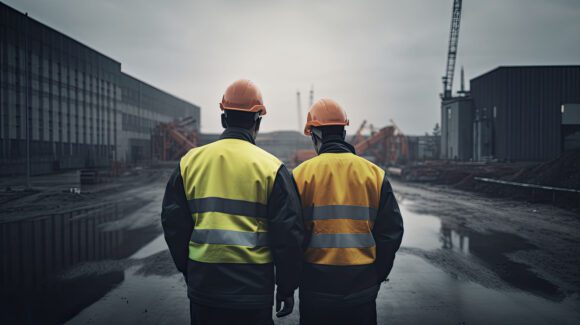5 Ways to Prevent Water Damage in Buildings Under Construction

This post is part of a series sponsored by IAT Insurance Group.
Water damage stands as a persistent threat to buildings under construction, ranking as one of the leading causes of property loss worldwide.
In the U.S. alone, the annual incurred loss amounts attributed to weather and non-weather-related water damage are equal to $500 million[1], emphasizing the significant financial burden this damage can place on construction projects.
As buildings take shape, water may seep in through various avenues, exploiting vulnerabilities by way of surface water flooding, uncovered or temporary roof systems, wind-driven rains, water service supply lines, and water drain lines. Understanding the pervasive nature of water and its ability to infiltrate any available opening underscores the need for robust risk management strategies.
How to establish a job site specific plan
The first and most important step in preventing water damage during construction is to establish a job site specific plan. Each project will have its own challenges based on location, topography construction methods and intended occupancy. General Contractors or Construction Managers should designate a competent individual to oversee and manage the site specific plan and ensure ample staff and appropriate supplies are available to minimize potential loss. The following five steps will help in your plan creation.
Establish day one site grading and ground water controls. Have engineered storm water drain systems installed as early as possible. The site grading should direct water away from the building. Keep drains clear throughout the construction process using silt fencing and/or hay bales to keep foreign material out. Ensure the availability of working pumps to remove water from pits, excavations, and other low-lying areas where water is not desired.
Protect materials, supplies and building systems. Supplies and materials that are highly susceptible to water damage such as drywall, ceiling tiles, and electrical components should wait to be delivered until the building is watertight. If early delivery is necessary, protect what you’ve got stored at the job site by using tarps to cover items and keeping items raised off the floor with pallets.
Monitor weather and have a plan for approaching storms. Whenever possible, do not start interior finish work such as drywall, paint and trim work on floors where walls, window openings and roofs are not completed. If work must continue, take every precaution to protect these areas with substantial wind-resistant plastic sheeting and other water-proofing methods such as temporary roof systems.
Pay special attention to floor openings such as electrical chases or elevator shafts where water can damage equipment and wiring on multiple floors. Seal openings where possible or install temporary dikes to keep any surface water out. During rains, have staff and supplies available to respond to any water-related emergency to minimize damage.
During construction, limit active water sources within the building. It is best to have available water needed for construction activity limited to the ground floor during construction. This minimizes damage if a leak occurs or someone forgets to fully close a faucet. Charged water and drain lines within the building should be pressure tested and fully inspected prior to placing into service. Where applicable, protect pipes from freezing temperatures with permanent building heating systems.
Consider installing water detection or flow alarms in areas that may be particularly susceptible to damage. This is also important for charged systems that should not see normal water flow such as automatic sprinkler systems. Water detection systems can detect water at the floor level and send a notification of the presence of water.
Perform building inspections. Whether or not inclement weather is predicted, it’s important to protect against potential water damage. At the end of each work day, ensure windows and doors are shut and any temporary tarps or roofs are properly secured. Plumbing work should be checked for visible leaks, and confirm all water faucets are completely shut off. Periodically performing a full inspection of your job site also is recommended.
Best Practice: Shut off water supplies at the main service valves prior to leaving the project for any significant length of time. Consider doing this ahead of a weekend or holiday period to ensure peace of mind for those involved in the project.
ASK A LOSS CONTROL REPRESENTATIVE
Have a question on how to mitigate risk? Email losscontroldirect@iatinsurance.com for a chance to see your question answered in a future blog.
By John Holpuch
[1] Risk & Insurance “Water Damage Is a Leading Cause of Commercial Real Estate Claims. How Sensor Technologies Help Mitigate These Claims,” July 26, 2023.
Topics
Construction
Interested in Construction?
Get automatic alerts for this topic.





